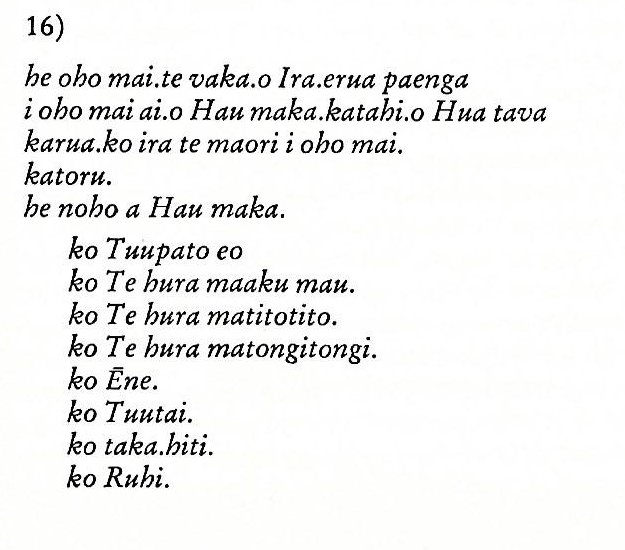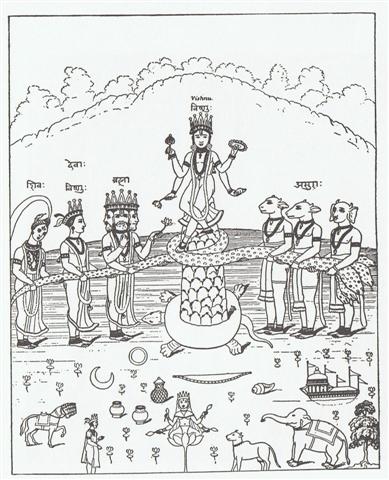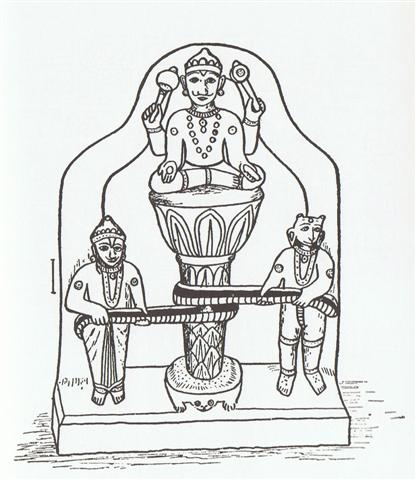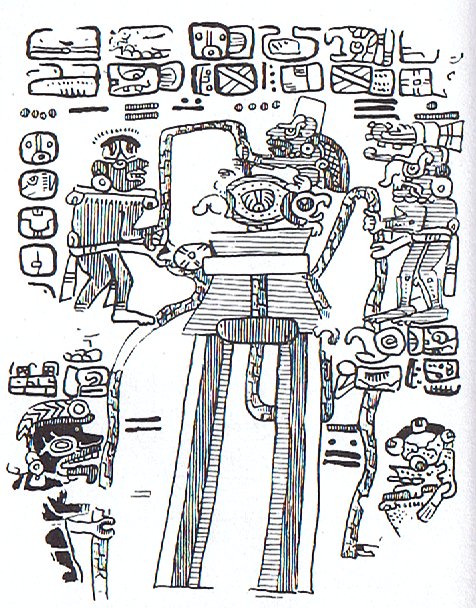
Here the full length of the pages were suddenly no longer used.
However, having noticed this fact and going back to look again
we will find the symmetry was broken already with the number of
lines on page E:15, where the creator of the text evidently had made
the number to be 14 + 3 = 17.
And then we can perceive how the last 10 lines on page E:14
together with those 17 on page E:15 will spell out number 27 (=
24 + 3):
|
E:14 |
|
aau.he ki a Matua.e hatu koe ki hu |
Matua spoke [ki]:
'Instruct [hatu] the young men how they
must sail to see [ui] the (new home)
land.
It will be their task to remain (there) until
next year and not hurry back here (immediately).
When you speak to the young men, tell them
that these orders are from me, the orders of
King Matua.
Tell them that they have only one year('s
time) to finish [oti] the canoe [miro]
and to launch it.
Tell them that it is up to them not to forget
anything.
Go and deliver the order!'
This was the end [oti] of Matua's
speech [ki]. |
|
ngaio era ana oho ana ui i te kainga |
|
e noho ki tahi tau he mee o veveveve mai |
|
ana ki koe ki hu ngaio era.aaku i ki atu o |
|
te ariki a Matua.koe ana ki etahi no |
|
tau o te miro he oti te tuku he hoa atu |
|
koe ana ki he mee o rehu.ka oho ka unga. |
|
he oti te ki nei a Matua. |
| he
ea a hau maka he oho ki toona hare he |
Hau Maka arose [he
ea] and went to his house [hare].
When he arrived [he tuu], he told Hua Tava
of the conversation: 'This is what the king said to
me, so that I may go and instruct the young men.'
Hua Tava answered [he ki mai] Hau Maka:
'Since this is what the king told you, go and
deliver (the order) to all; set out, look at the
land, and find a place where
the people (aniva) can live!'
Hau Maka spoke to his first-born son [atariki]
Ira, to Raparenga, and also to the sons of Hua Tava
- |
| tuu
he ki i te ki kia hua tava.penei e ku ki |
| mai
ana te ariki a Matua kia au mo unga |
| i
tau ngaio ena. |
| he
ki mai a hua tava.kia Hau maka. |
| ana
ki ro atu te ariki kia koe ka unga ana(-) |
|
nake.ka oho ka ui te kainga mo noho o |
|
te aniva.he ki a Hau
maka.ki taana |
| kope
atariki.kia Ira.kia
Raparenga. |
| ki
te ngaio tokoa a Hua tava. |
|
E:15 |
| ko
Ngukuu . a Hua tava.ko
Ringiringi |
namely, Kuukuu A Hua
Tava, Ringiringi A Hua Tava, Nonoma A Hua Tava, Uure
A Hua Tava, and Makoi A Hua
Tava. |
| a
Hua tava.ko Nonoma.a
Hua tava. |
| ko
Uure.a Hua tava. Ko
Makoi.a Hua |
|
tava. |
| he
ki a Hau maka.kia Ira.ka hoa toko(-) |
Hau Maka said [he ki]
to [kia] Ira: 'Take the crew and launch your
canoe; set sail and look for the land in the
direction of the rising sun (a roto i te raa).
When you sail and look to this direction, you
will find it lying there, its contours will
stand out [revareva]
on high in the midst of the (rising) sun (i roto
i te runga i te raa) (i.e. in the east).'
That was the first point. |
| rua
vaka ko nga kope ka oho ka ui te kainga |
| a
roto i te raa.ana oho ana ui.na e.moe ena. |
| e
tau e revareva ena. i
runga.i roto i te raa. |
|
katahi. |
| he
hakahi.tahi a Hau maka.i te mee i ti(-) |
Hau Maka gave a complete
description of all the things his dream soul had
seen. At that, all of them said in amazement. 'Ah!
Ah!' He described everything in the smallest detail
(? ka paepae-tahi-ro).
That was the second point. |
| kea
e toona kuhane.anakeanake aaaaa |
|
aaaaa ka paep(a)e tahi ro ina etahi i toe. |
|
karua. |
| he
oho.ananake ngaio he
tono i te vaka he hoa |
All [ananake] the
young men [ngaio] got ready, launched the
canoe, and anchored it out at sea [ki te tai].
They took on yam roots [te uhi], sweet
potatoes [te kumara], hard fruit (? makoi),
and bananas [te maika].
They stored [he ngatu] all sorts of food [anakeanake
te kai] in the canoe, and the canoe set sail. |
| ki
haho ki te tai.he too i te uhi i te kumara i |
| te makoi i te maika.anakeanake
te kai. |
|
he ngatu ki roto ki te
vaka. he oho mai te vaka |
| Anake, unique. T
Pau.: anake, unique, to be alone. Mgv.:
anake, alone, single, only, solely. Mq.:
anake, anaé, id. Ta.: anae, all,
each, alone, unique. Anakena, July.
Ananake, common, together, entire,
entirely, at once, all, general, unanimous,
universal, without distinction, whole, a company;
piri mai te tagata ananake, public; kite aro
o te mautagata ananake, public; mea ananake,
impartial; koona ananake, everywhere.
Churchill.
Gatu. Gaatu, totora reed. Gatu: 1.
To press, to tighten, to squeeze. 2. To pack tight.
3. To pull suddenly, to give a jerk. I ka
hakarogo atu, ku eke á te kahi, he gatu mai, as
soon as he felt the tuna be, he pulled in [the line]
with a sharp jerk. 4. To kick. 5. E gatu te hagu,
to wait for something impatiently (gatu,
breath). 6. Shortly, very soon. He tu'u gatu,
he is coming shortly, he is just about to arrive.
Vanaga. Bulrush, reed. Gaatu (gatu) 1.
To feel of, to pinch, to throttle with the hands, to
touch, to press (gaatu); gatuga,
pressure; gatugatu, to trample down. T Mgv.:
natu, to press out linen, to squeeze a person
or a sore place. Mq.: natu, to pinch. Ta.:
natu, to pinch, to bruise. 2. To suppurate. 3.
Gatu mai gatu atu, sodomy. Gatua (gatu
1), tractable, to press. Churchill. Scirpus
riparius var. paschalis. Barthel 2. |
In the overview below we can see that 18
lines per page was used from page E:5, which means the sum of
the text lines up to and including those on page E:15 can be
counted for instance as 6 (E:5) + 9 * 18 + 17 (E:15) = 185 (= 740 / 4):
|
PAGES |
|
1 |
2 |
3 |
4 |
5 |
6 |
|
NUMBER
OF TEXT LINES |
|
14 |
17 |
9 |
6 + 4 |
12 + 6 |
18 |
|
40 |
|
46 + 16
+ 24 = 68 + 18
= 86
(=
50 + 6 *
6) |
|
PAGES |
|
7 |
8 |
9 |
10 |
11 |
12 |
|
NUMBER OF TEXT LINES |
|
18 |
18 |
18 |
18 |
18 |
18 |
|
108
(= 3 * 36 = 4 * 27) |
|
PAGES |
|
13 |
14 |
15 |
16 |
|
NUMBER OF TEXT LINES |
|
18 |
8 + 10 |
17 |
13 |
|
26 +
27 + 13 =
66
(= 260 - 50 - 144) |
... It is known that in the final battle of
the gods, the massed legions on the side of 'order' are the dead
warriors, the 'Einherier' who once fell in combat on earth and
who have been transferred by the Valkyries to reside with Odin
in Valhalla - a theme much rehearsed in heroic poetry. On the
last day, they issue forth to battle in martial array. Says
Grimnismal (23): 'Five hundred gates and forty more - are in
the mighty building of Walhalla - eight hundred 'Einherier' come
out of each one gate - on the time they go out on defence
against the Wolf.' That makes 432,000 in all, a number of
significance from of old. This number must have had a very
ancient meaning, for it is also the number of syllables in the
Rigveda. But it goes back to the basic figure 10,800, the
number of stanzas in the Rigveda (40 syllables to a
stanza) [40 * 270 = 10800] which, together with 108, occurs
insistently in Indian tradition, 10,800 is also the number which
has been given by Heraclitus for the duration of the Aiōn,
according to Censorinus (De die natali, 18), whereas
Berossos made the Babylonian Great Year to last 432,000 years.
Again, 10,800 is the number of bricks of the Indian fire-altar
(Agnicayana). 'To quibble away such a coincidence', remarks
Schröder, 'or to ascribe it to chance, is in my opinion to drive
skepticism beyond its limits.'
Shall one add Angkor to the list? It has five
gates, and to each of them leads a road, bridging over that
water ditch which surrounds the whole place. Each of these roads
is bordered by a row of huge stone figures, 108 per avenue, 54
on each side, altogether 540 statues of Deva and Asura, and each
row carries a huge Naga serpent with nine heads. Only, they do
not 'carry' that serpent, they are shown to 'pull' it, which
indicates that these 540 statues are churning the Milky Ocean,
represented (poorly, indeed) by the water ditch, using Mount
Mandara as a churning staff, and
Vasuki, the prince of the Nagas, as their drilling rope. (Just
to prevent misunderstanding: Vasuki had been asked before, and
had agreeably consented, and so had Vishnu's tortoise avatar,
who was going to serve as the fixed base for that 'incomparably
mighty churn', and even the Milky Ocean itself had made it clear
that it was willing to be churned.)

The 'incomparably mighty churn' of the Sea of
Milk, as described in the Mahabharata and Ramayana.
The heads of the deities on the right are the Asura, with
unmistakable 'Typhonian' characteristics. They stand for the
same power as the Titans, the Turanians, and the people of
Untamo, is short, the 'family' of the bad uncle, among whom Seth
is the oldest representative, pitted against Horus, the avenger
of his father Osiris.

The simplified version of the Amritamanthana
(or Churning of the Milky Ocean) still shows Mount Mandara used
as a pivot or churning stick, resting
on the tortoise. And here, also, the head on the right has
'Typhonian' features. The whole of Angkor thus turns out to be a
colossal model set up for 'alternative motion' with true Hindu
fantasy and incongruousness to counter the idea of a continuous
one-way Precession from west to east ...

|



